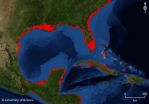(Press-News.org) A genetic study focusing on the Central American river turtle (Dermatemys mawii) recently turned up surprising results for a team of Smithsonian scientists involved in the conservation of this critically endangered species. Small tissue samples collected from 238 wild turtles at 15 different locations across their range in Southern Mexico, Belize and Guatemala revealed a "surprising lack" of genetic structure, the scientists write in a recent paper in the journal Conservation Genetics.
The turtles, which are entirely aquatic, represent populations from three different river basins that are geographically isolated by significant distance and high mountain chains.
"We were expecting to find a different genetic lineage in each drainage basin," explains the paper's main author Gracia González-Porter of the Center for Conservation and Evolutionary Genetics at the Smithsonian Conservation Biology Institute. "Instead, we found the mixing of lineages. It was all over the place." Despite appearing isolated, the genetic data showed the different turtle populations had been in close contact for years.
"But how?" the researchers wondered.
The best possible explanation, González-Porter and her colleagues say, is that for centuries humans have been bringing them together. The turtles have been used as food, in trade and in rituals for millennia, widely transported and customarily kept in holding ponds till they were needed.
"For centuries, this species has been part of the diet of the Mayans and other indigenous people who lived in its historic distribution range," the scientists point out in their paper. "D. mawii was a very important source of animal protein for the ancient Mayans of the Peten (Preclassic period 800-400 B.C.)…. And it is possible that these turtles were part of the diet of the Olmec culture more than 3,000 years ago."
One specimen of D. mawii was found in an ancient Teotihuacan burial site in Mexico, a spot located more than 186 miles from the known range of this turtle, the researchers say. An ancient sculpture of a Central American river turtle at the National Museum of Anthropology in Mexico City was found in the Basin of Mexico, more than 217 miles from the turtle's range.
"The Central American River turtle is tame and resilient," González-Porter explains, "which makes it easy to transport. Their shells give them lots of protection. People don't have refrigeration so they put the turtles in ponds in their back yards."
During the rainy season in the tropics, the water flows are huge, she says. Rivers and ponds flood, captive turtles escape and mix with the local turtles.
This ancient practice still persists today. In Guatemala, Central American river turtles are kept in medium-sized ponds where they can be easily captured when needed. Similarly, in the State of Tabasco, Mexico, captured turtles are kept in rustic ponds and raised until they are either consumed or sold.
The genetic analysis of the Central American River turtle was initiated because these animals are critically endangered, González-Porter says.
They are the last surviving species of the giant river turtles of the family Dermatemydidae. D. mawii is currently the most endangered turtle species in Central America. A recent increase in the commercial demand for its meat has pushed it to the brink of extinction—2.2 pounds of their meat can fetch $100. Most local populations have disappeared and this turtle is now largely restricted to remote areas that are inaccessible to humans.
INFORMATION:
The article "Patterns of genetic diversity in the critically endangered Central American river turtle: human influence since the Mayan age?" was co-authored by Gracia González-Porter and Frank Hailer of the Center for Conservation and Evolutionary Genetics at the Smithsonian Conservation Biology Institute; Jesús Maldonado of Center for Conservation and Evolutionary Genetics at the Smithsonian Conservation Biology Institute and the Department of Vertebrate Zoology at the Smithsonian's National Museum of Natural History; Oscar Flores-Villela of the Museo de Zoología Facultad de Ciencias, México; and Rony Garcia-Anleu of the Wildlife Conservation Society-Guatemala Program, Guatemala.
Endangered river turtle's genes reveal ancient influence of Maya Indians
2011-07-22
ELSE PRESS RELEASES FROM THIS DATE:
Massachusetts health-care reform increased access to care, particularly among disadvantaged
2011-07-19
Recent research conducted at Harvard Medical School and the Harvard School of Public Health may have strong implications for informing the controversial debate currently surrounding national health care reform.
In a study published in the July edition of the American Journal of Preventive Medicine, the Harvard research team, led by first author Aakanksha Pande, a doctoral student in the Department of Population Medicine at HMS and Harvard Pilgrim Health Care Institute, found that Massachusetts health reform has effectively increased access to health care and reduced disparities. ...
Children with public health insurance less likely to receive comprehensive primary care
2011-07-19
ANN ARBOR, Mich. — Children with public insurance are 22 percent less likely to receive comprehensive primary care than those with private insurance, according to new research from the University of Michigan Medical School.
Public insurance programs cover one-third of U.S. children, many of whom belong to the most vulnerable groups, including minorities, the underprivileged and those in poor health. This includes children covered by Medicaid and the Children's Health Insurance Program (CHIP).
The study, available online ahead of print in Academic Pediatrics, determined ...
Typhoon Ma-on's eye seen in NASA satellite Images
2011-07-19
The eye of a tropical cyclone is an indication of a strong storm, and Typhoon Ma-on's eye was apparent in visible and infrared imagery captured by NASA's Aqua satellite. Ma-on just achieved Category Four status on the Saffir-Simpson scale that measures hurricane intensity.
The Moderate Resolution Imaging Spectroradiometer (MODIS) instrument that flies aboard NASA's Aqua satellite took an image of Typhoon Ma-on that clearly shows the storm's eye, although it has some high clouds in it. The image was taken at 04:15 UTC (12:15 a.m. EDT) on July 15 as Typhoon Ma-on continues ...
NASA's Aura satellite measures pollution 'butterfly' from fires in central Africa
2011-07-19
Fires raging in central Africa are generating a high amount of pollution that is showing up in data from NASA's Aura Satellite, with the ominous shape of a dark red butterfly in the skies over southern part of the Democratic Republic of the Congo and northern Angola.
An image of the pollution from agricultural fires in central Africa was created from data of nitrogen dioxide (NO2) levels over the period from July 7 to 12, 2011. It was created from Ozone Measuring Instrument (OMI) data using the NASA Giovanni system by Dr. James Acker at NASA's Goddard Space Flight Center ...
Nursing home residents at heightened risk of falling in the days following
2011-07-19
BOSTON—Nursing home residents taking certain antidepressant medications are at an increased risk of falling in the days following the start of a new prescription or a dose increase of their current drug, according to a new study by the Institute for Aging Research of Hebrew SeniorLife, an affiliate of Harvard Medical School.
Published online in the Journal of Gerontology: Medical Sciences, the study found that nursing home residents have a fivefold increased risk of falling within two days of a new prescription for or an increased dose of a non-SSRI (selective serotonin ...
New health-care payment system slows spending while improving patient care
2011-07-19
In a new study with implications for state and federal efforts to reform payments to doctors and hospitals to encourage greater coordination of care, Harvard Medical School researchers found that a global payment system underway in Massachusetts lowered medical spending while improving the quality of patient care relative to the traditional fee-for-service system.
The study, published today in the New England Journal of Medicine, examined the Alternative Quality Contract (AQC), which was first introduced by Blue Cross Blue Shield of Massachusetts (BCBSMA) in 2009 and ...
World's forests' role in carbon storage immense, profound
2011-07-19
Fairbanks, Alaska—Until now, scientists were uncertain about how much and where in the world terrestrial carbon is being stored. In the July 14 issue of Science Express, scientists report that, between 1990 and 2007, the world's forests stored about 2.4 gigatons of carbon per year.
Their results suggest that forests account for nearly all of the world's land-based carbon uptake. Boreal forests are estimated to be responsible for 22 percent of the carbon stored in the forests. A warming climate has the potential to increase fires and insect damage in the boreal forest ...
Scientists seek to increase science literacy
2011-07-19
Fairbanks, Alaska—A scientist at the University of Alaska Fairbanks and colleague at Emory University are seeking to persuade the National Science Foundation to reevaluate its decision to cancel a program that has placed 10,000 science graduate students in more than 6,000 K-12 public schools across the country.
In an editorial in the July 15 issue of the journal Science, UAF biology professor Richard Boone and Emory University professor Pat Marsteller advocate for developing an enhanced version of NSF's Graduate Science, Technology, Engineering and Mathematics Fellows ...
Making blood-sucking deadly for mosquitoes
2011-07-19
Mosquitoes die soon after a blood meal if certain protein components are experimentally disrupted, a team of biochemists at the University of Arizona has discovered.
The approach could be used as an additional strategy in the worldwide effort to curb mosquito-borne diseases like dengue fever, yellow fever and malaria.
When the researchers blocked a cellular process known as vesicle transport, on which the mosquitoes rely to release digestive enzymes into the gut among other functions, it caused the affected animals to die within two days of blood feeding.
"The idea ...
Rising oceans -- too late to turn the tide?
2011-07-19
Thermal expansion of seawater contributed only slightly to rising sea levels compared to melting ice sheets during the Last Interglacial Period, a University of Arizona-led team of researchers has found.
The study combined paleoclimate records with computer simulations of atmosphere-ocean interactions and the team's co-authored paper is accepted for publication in Geophysical Research Letters.
As the world's climate becomes warmer due to increased greenhouse gases in the atmosphere, sea levels are expected to rise by up to three feet by the end of this century.
But ...




